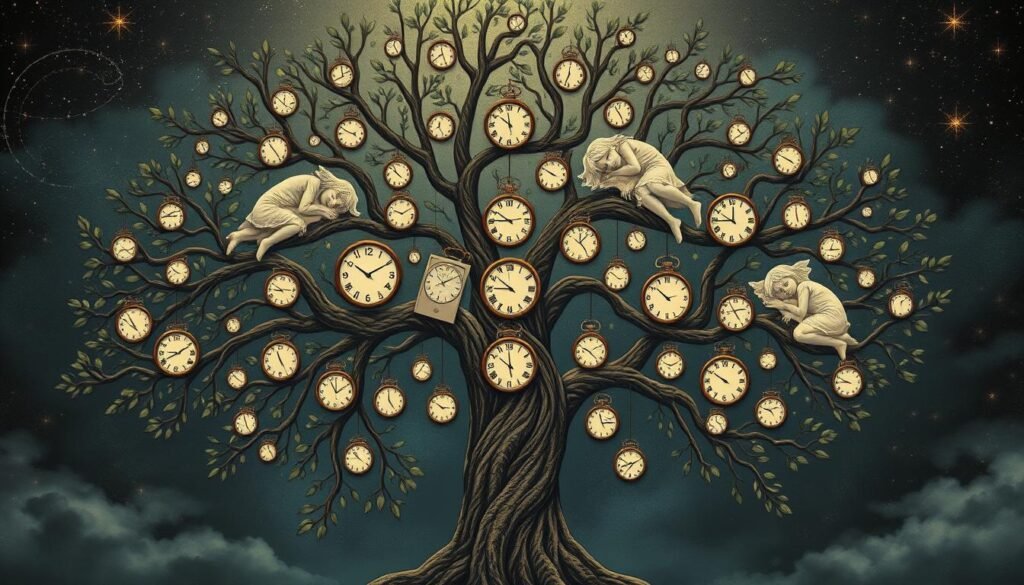Did you know around 30% to 35% of people have occasional insomnia symptoms? This problem doesn’t just affect how you do every day. It also touches your overall health, and women face it more often. Is insomnia part of our genetics, then? Studies show that 31% to 58% of insomnia risk comes from our genes. It’s key to understand genetics to tackle this issue. It’s important, too, to think about how our surroundings play a role. Knowing how our genes and environment mix helps us grasp insomnia better. It shows us how deeply it affects our lives.
Key Takeaways
- 30% to 35% of individuals may suffer from insomnia symptoms at some point.
- Heritability estimates suggest genetics account for 31% to 58% of insomnia risk.
- Women show a higher heritability of insomnia compared to men.
- Environmental factors and lifestyle choices also significantly influence sleep quality.
- Conditions like anxiety, depression, and restless legs syndrome are often linked to insomnia.
Introduction to Insomnia and Its Impact
Insomnia is a sleep disorder that affects many adults. About 30% of adults worldwide report symptoms of insomnia. These symptoms include trouble starting and keeping sleep, plus feeling unrested after sleeping. The number drops to about 10% with stricter diagnosis, yet its impact is significant.
Insomnia’s effects go beyond just bad sleep. Those with insomnia often experience emotional upset, tiredness during the day, and trouble thinking. Research shows 75%-90% of people with insomnia might also face other health issues. These issues can make their situation worse.
Insomnia often comes with mental health problems, with around 40% of sufferers also having a psychiatric condition, like depression. Insomnia’s fallout includes a higher chance of accidents and reduced productivity at work. It can lead to more sick days and less effective job performance.
Patients with insomnia often spend 60% more on healthcare than others. The reach of insomnia underlines the need for understanding its causes better. This includes looking at genetic factors. Solving insomnia matters for better sleep and improving overall health and happiness.
Understanding Sleep Disorders and Their Prevalence
Sleep disorders include many conditions, with insomnia at the top. It’s troubling that 6% to 10% of adults suffer from chronic insomnia. This fact shows how sleep troubles greatly affect our lives and health.
Who gets insomnia can depend on their gender or age. Women, especially during pregnancy and menopause, have it worse than men. As people get older, they also become more at risk of having sleep disorders.
Our genes play a big part in sleep disorders too. Disorders like restless legs syndrome (RLS) run in families, with 40%-60% of patients having a relative who also has it. This points to a strong genetic root in insomnia, urging further research into genetic markers.
Specific genetic markers are linked to insomnia and similar disorders. Narcolepsy, for instance, is connected to the HLA DQB1*0602 gene. Research has also found certain genes that may cause RLS and PLMS, illuminating the genetic background of these issues.
Some conditions, like obstructive sleep apnea and familial insomnia, seem to be genetically based too. But finding the exact genes for obstructive sleep apnea is hard. A gene called the angiotensin-converting enzyme might be involved, yet this is still uncertain.
The complex relationship between genetics and sleep issues like chronic insomnia needs more clarity. More research could lead to better treatments. For a deeper understanding of genetics in sleep disorders, check out this resource at PMC.
The Genetics of Insomnia
Exploring the genetics of insomnia shows how much it can be passed down in families. Studies show that genes play a big role in many insomnia cases. They estimate that genes are behind 22% to 59% of all insomnia problems. This shows why family history matters a lot.
Heritability of Insomnia
Research with twins and families shows a big link between our genes and insomnia. In kids and teens, genetics is partly to blame. The amount goes from 33% to 38% when young, then drops to 14% to 24% later on. Things like habits and where we live also affect insomnia. Yet, what makes each person’s experience different has the biggest impact.
Signs of specific insomnia genes show up around age 8. As people get older, these genetic signs stay strong. By age 10, new genetic factors emerge. This calls for more research into how genes affect our sleep. Knowing more about these genetics could help find special treatments and better understand sleep issues.
Notable Genetic Markers Related to Insomnia
Big genetic studies have found many areas in our DNA linked to insomnia. One study with over 1.3 million people found more than 200 of these areas. Another big analysis looked at over 593,000 cases. It found 554 places in our DNA that could be risks for insomnia. These findings open up new paths for treatments.
These studies found thousands of genes that might be involved. They focus on genes that affect how brain cells talk to each other and grow. The close link between insomnia, brain health, and body health shows how complex sleep problems are. This points to how many sides there are to sleep disorders.
Is Insomnia Genetic? Exploring the Connection
To understand insomnia, we look at family history and how common it is in certain groups. Studies show people with a family history of insomnia are more likely to have trouble sleeping too. This suggests that the risk of getting insomnia might be passed down in families. In fact, genetics might account for 38% to 59% of someone’s risk of developing insomnia during their lifetime.
Role of Family History in Insomnia
Research into families has shown that insomnia often runs in families, pointing to a genetic link. By comparing insomnia in family members, researchers can see how much genetics play a role. Twin studies add more evidence, indicating genetics significantly influence insomnia. This stresses the need to consider genetic risk factors for insomnia in sleep disorder research.
Prevalence Among Different Demographics
Insomnia affects about 6% to 10% of people, but one in three adults faces sleep issues at night. Women face sleep problems more than men, highlighting gender’s role in insomnia. Age and other factors like lifestyle and work schedules also impact who gets insomnia.
| Demographic Factor | Prevalence of Insomnia |
|---|---|
| Overall Population | 6% – 10% |
| Adults Experiencing Symptoms | 33% |
| Women | Higher prevalence compared to men |
| Older Adults | Increased prevalence |

More research can help us understand how insomnia is linked to family history, aiding treatment and prevention. Looking at genetic details, like single nucleotide polymorphisms (SNPs), sheds light on insomnia’s genetic roots. To dive deeper into this topic, you can read more here.
Chronic Insomnia and Genetic Susceptibility
Chronic insomnia is a big problem for many people. It really affects their life quality. Recent studies show that our genes play a big role in getting chronic insomnia. This research says that our DNA, not just our surroundings, might cause our sleep problems.
Patterns Seen in Long-Term Insomnia Cases
Looking at long-term insomnia helps us understand the genetic side better. Twin studies reveal that genes are very important. For instance, insomnia heritability is about 43% in males and 55% in females. This shows a strong genetic connection. Identical twins have more similar insomnia issues than fraternal twins, highlighting genetics’ role.
Furthermore, different insomnia problems are linked to different genes. Problems like staying asleep have a big genetic component, about 25% to 35%. But having trouble falling asleep doesn’t seem linked to genes. This difference shows how our genes influence specific insomnia types.
Studies also find genetic links to insomnia in children, shown in sleep issues like waking up often. When mothers report their children’s sleep problems, it suggests genes may play a role from a young age. Knowing these patterns helps in making plans and prevention for those affected.
Familial Insomnia and Its Characteristics
Familial insomnia is a rare inherited sleep disorder. It has characteristics of familial insomnia that make it different from other types. The condition is known to pass down through generations. This suggests genetics play a big role. Most people start showing symptoms between ages 20 and 70. Age 40 is when many first notice the signs.
One of the worst types is called fatal familial insomnia. It involves a mutation in the PRNP gene. This mutation changes how a brain protein, PrPC, is made. This leads to serious problems. If one parent has the gene, their child might inherit the condition. This is due to its autosomal dominant nature.
The characteristics of familial insomnia also include other issues, not just sleep problems. People may have mental health and movement issues first. Then, they find it hard to sleep. As the disorder gets worse, it leads to major mental and physical problems.
Even though familial insomnia is rare, it affects families deeply. Worldwide, about 100 people in 30 families have the gene causing fatal familial insomnia. This is why learning and understanding the disorder is key. It helps patients and their families deal with inherited sleep disorders.
To wrap up, familial insomnia involves both genetics and sleep troubles. Being aware of its signs helps in finding treatments. It also aids families in coping with the condition.

Understanding Insomnia Causes Beyond Genetics
Insomnia is more than a genetic issue. Other factors play big roles in causing sleep problems. Environmental and lifestyle factors are key. Understanding these can help explain why some people find sleeping tough.
Environmental and Lifestyle Influences
Numerous environmental factors impact sleep. Stressful jobs, traveling a lot, and screen time before bed disrupt sleep. Changed work habits like more remote work have also shifted how we sleep.
How we live affects our sleep too. Bad eating habits, not exercising, and using caffeine or alcohol can make insomnia worse. Mental health issues like anxiety and depression also affect sleep. They often make sleep quality drop.
Your genes play a part in sleep problems. But, lifestyle influences on sleep matter too. Even with a family history of insomnia, changing your lifestyle could improve your sleep.
Genetics and these factors together help explain insomnia. Epigenetic studies show that our environment can change how our genes work. This can affect our sleep for better or worse.
| Factor | Impact on Sleep |
|---|---|
| Stress | Increases cortisol levels, reducing the ability to sleep peacefully. |
| Screen Time | Exposure to blue light interferes with melatonin production. |
| Caffeine | Acts as a stimulant, making it hard to fall asleep. |
| Alcohol | Although it may induce sleep, it disrupts the sleep cycle. |
| Exercise | Regular physical activity promotes better sleep quality. |
| Sleep Environment | A comfortable, dark, and quiet environment enhances sleep. |
To really grasp insomnia, we must look at genes and lifestyle choices. By tackling these issues, better sleep is possible for individuals.
Sleep Difficulties and Associated Health Conditions
Many adults struggle with sleep, with 10% facing insomnia disorder. This issue is more than trouble sleeping; it’s tied to genetics and health problems. People genetically prone to insomnia might also be at higher risk for certain diseases.
Conditions Linked to Genetic Predisposition for Insomnia
Insomnia often comes with other health issues. Genetics may be the link. Important connections include:
| Health Condition | Relation to Insomnia |
|---|---|
| Depression | Strong genetic correlation (rG = 0.59) |
| Anxiety Disorders | High genetic link (rG = 0.56) |
| Obesity | Increased risk of obstructive sleep apnea |
| Cardiovascular Disease | Linked to poor sleep and insomnia (rG = 0.18) |
| Type 2 Diabetes | Genetic correlation (rG = 0.20) |
| Chronic Pain | Influences sleep difficulties |
Research points to genetics as a key factor in these issues. For instance, a study in the Journal of Psychology and Psychiatry talks about the inherited aspects of some sleep disorders. It’s clear that sleep problems and other health issues, such as high blood pressure or heart failure, can come from genetic roots.

Knowing the genetic links with insomnia can help create better treatments. These could improve sleep and reduce the risk of related health problems.
Genetic Testing for Insomnia
Genetic testing for insomnia is getting a lot of attention in research. This interest comes from wanting to know how our genes can affect sleep problems. Although progress has been made in spotting genes linked to insomnia, using this knowledge is still a work in progress.
Studies suggest genes might determine 38% to 59% of the risk of getting insomnia in one’s lifetime. But, creating a testing method directly linked to genetics is tricky.
Current Research and Limitations
So far, research has found as many as 956 genes that could be linked to insomnia. This number shows just how complex the genetic factors can be. But, there are big challenges in making genetic tests that work well in the real world. Things like how much we move and what we eat also play a big role in our sleep quality.
The issues with genetic testing don’t stop there. Many studies look at broad groups of people and might not zero in on specific groups. Also, while we understand some rare genetic sleep disorders well, most insomnia issues come from both our genes and our environment. More research is vital for better grasping the genetic side of sleep and how it can lead to new treatments.
Improving Sleep: Techniques and Strategies
Quality sleep is key to staying healthy and feeling good. If you find it hard to sleep, learning and using effective techniques can greatly improve how well you sleep. It’s important to start with good sleep habits to beat these issues.
Establishing Good Sleep Hygiene Practices
Creating a sleep-friendly space is the first step to better sleep. Here are some helpful insomnia strategies to make your space more inviting for sleep:
- Maintain a Consistent Sleep Schedule: Sleeping and waking up at the same time each day helps your body’s clock stay regular.
- Create a Calming Bedtime Routine: Doing relaxing things like reading or taking a warm bath tells your body it’s time to rest.
- Optimize the Sleeping Environment: A good mattress, comfy bedding, and a room that’s dark and quiet make sleep better.
- Limit Screen Time Before Bed: Avoiding screens for at least an hour before sleep can cut down on sleep problems.
- Watch Food and Drink Consumption: Staying away from caffeine 8 hours before bed and not drinking alcohol 4 hours before can help your sleep.
- Incorporate Relaxation Techniques: Using meditation and journaling can help deal with stress, which often causes trouble sleeping.
- Utilize Natural Light: Getting at least 30 minutes of natural light a day can help you maintain a natural sleep cycle.
By working on these simple habits, you can greatly increase your chances of getting rid of insomnia. For more tips on dealing with insomnia symptoms and why sleep hygiene is important, check out the article on the risks of not treating it.
Conclusion
Insomnia is a complex condition influenced by genes, environment, and lifestyle. Despite the role of genetics, they don’t solely predict one’s sleep health. This is because genetics mix with our upbringing and habits. This mix explains why insomnia affects some people but not others.
Some kids inherit sleeping problems, leading to insomnia in their teen years. But it’s key to remember that habits matter too. Things like how parents set bedtimes matter. By following good sleep habits, people can better their sleep health.
Research is key in fully getting the scope of insomnia. If you often find it hard to sleep, getting help is crucial. Insomnia requires dealing with several aspects to truly overcome it. Chronic insomnia’s link to serious health issues like heart disease calls for quick action. Learn more about these risks here.